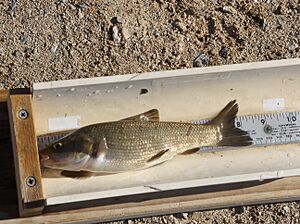Mohave tui chub facts for kids
Quick facts for kids Mohave tui chub |
|
|---|---|
 |
|
| Conservation status | |
| Scientific classification |
|
| Kingdom: | Animalia |
| Phylum: | Chordata |
| Class: | Actinopterygii |
| Order: | Cypriniformes |
| Family: | Leuciscidae |
| Genus: | Siphateles |
| Species: | |
| Subspecies: |
S. b. mohavensis
|
| Trinomial name | |
| Siphateles bicolor mohavensis Snyder, 1918
|
|
| Synonyms | |
|
|
The Mohave tui chub (Siphaletes bicolor mohavensis) is a special type of tui chub fish. It lives only in the Mojave River area. This fish was declared endangered in 1970 by the United States. California also added it to its own endangered species list in 1971. A plan to help the fish recover was made in 1984.
Contents
About the Mohave Tui Chub
Adult Mohave tui chubs are usually about 5 to 9 centimeters (2 to 3.5 inches) long. Some can grow even bigger, up to 15 centimeters (6 inches) or more! They have a thick body and short, rounded fins. Their backs are brown to dark olive, and their bellies are bluish-white or silver. Male and female chubs look very similar.
These fish are super tough. They can live in the Mojave River's water, which can be very salty (alkaline), have low oxygen, and get very hot. Adult chubs like to be alone and usually stay in deeper parts of the water. They eat insect larvae, small fish, and tiny bits of dead plants and animals.
Reproduction and Life Cycle
Female Mohave tui chubs lay eggs from February to October. They can lay a lot of eggs, from 4,000 to 50,000! These eggs stick to plants in the water.
Saving the Mohave Tui Chub
Mohave tui chubs were once found in just a few isolated spots near Soda Springs. These spots included Lake Tuendae, Three Bats Pond, and MC Spring. Scientists think the chubs got to Soda Springs either by being moved there in 1945 or during a big flood in 1938.
Efforts to move the chubs to new safe places were mostly hard. Only three out of fourteen tries worked. These successful spots were Lark Seep Lagoon, Desert Research Station Pond, and Barstow Way Station Pond. The population at Lark Seep Lagoon, located at the China Lake Naval Weapons Center, still exists today after fish were moved there in 1971. The other two successful spots no longer have chubs.
In 1984, the U.S. Fish and Wildlife Service made a plan to remove the Mohave tui chub from the endangered list. The plan said that three more safe homes for the fish needed to be created. Each new home needed at least 500 fish. These new homes also had to survive a flood before the fish could be considered safe.
When the plan was checked again in 2004, it hadn't been fully put into action. However, there is a group of chubs living at Camp Cady today that were moved there. The recovery plan is still not fully completed. In 2004, experts met to talk about the plan again. They discussed putting the Mohave tui chub back into the Mojave River.
Scientists are also thinking about breeding these fish in labs. This could help increase their numbers. It could also provide fish for studies to help them survive better in the wild.
Why They Are in Danger
The biggest reason the Mohave tui chub numbers dropped was the arrival of the Arroyo chub. Arroyo chubs were brought to the river in the 1930s by people fishing for trout. A big flood in 1938 helped them spread even more. After they arrived, there were many Arroyo chubs and mixed-breed fish. By 1967, pure Mohave tui chubs were gone from the Mojave River.
Arroyo chubs are better at living in streams with low oxygen and high temperatures. This means they might have simply taken over the Mohave tui chub's habitat. Other non-native animals also hurt the chubs. These include bass, catfish, trout, bullfrogs, and crayfish. They either ate the chubs or competed with them for food. Also, building dams and reservoirs changed the river's natural flow. This created places where invasive species could thrive, further harming the chubs.
Another problem for the Mohave tui chub was the discovery of the Asian tapeworm in 2001. This worm lives inside freshwater fish. It likely spread with other fish like common carp. Studies are still looking into how much this tapeworm affects wild fish. One study in 2007 found that the tapeworm doesn't directly kill Mohave tui chubs. It only slightly slows their growth.
Scientists also looked at how western mosquitofish affect the chubs. While more study is needed, it seems that once Mohave tui chubs grow to a certain size, mosquitofish can't eat them. In fact, mosquitofish might even be a food source for the chubs!
Where They Live Now
As of 2013, there were three main groups of Mohave tui chubs. These are at Soda Lakes (Lake Tuendae and Mohave Chub spring), China Lake, and Camp Cady. The population at Camp Cady is doing well in two ponds. The Soda Lake population faces threats from mosquitofish and Asian tapeworms. The safest group is thought to be at China Lake.
The Mohave tui chub is still listed as endangered today. There haven't been many recent checks on their numbers. Some experts believe it's too hard to put the Mohave tui chub back into the main Mojave River. This is because it would be very difficult to remove the Arroyo chubs from such a large river. However, they suggest putting Mohave tui chubs into smaller streams, ponds, and other water areas upstream. This could create safe places for them to live and grow.
See also


